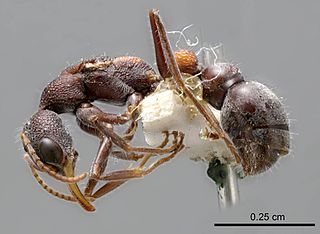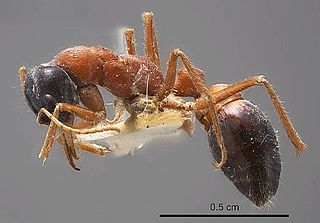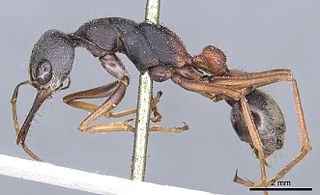
Myrmecia is a genus of ants first established by Danish zoologist Johan Christian Fabricius in 1804. The genus is a member of the subfamily Myrmeciinae of the family Formicidae. Myrmecia is a large genus of ants, comprising at least 93 species that are found throughout Australia and its coastal islands, while a single species is only known from New Caledonia. One species has been introduced out of its natural distribution and was found in New Zealand in 1940, but the ant was last seen in 1981. These ants are commonly known as bull ants, bulldog ants or jack jumper ants, and are also associated with many other common names. They are characterized by their extreme aggressiveness, ferocity, and painful stings. Some species are known for the jumping behavior they exhibit when agitated.

The jack jumper ant, also known as the jack jumper, jumping jack, hopper ant, or jumper ant, is a species of venomous ant native to Australia. Most frequently found in Tasmania and southeast mainland Australia, it is a member of the genus Myrmecia, subfamily Myrmeciinae, and was formally described and named by British entomologist Frederick Smith in 1858. This species is known for its ability to jump long distances. These ants are large; workers and males are about the same size: 12 to 14 mm for workers, and 11 to 12 mm for males. The queen measures roughly 14 to 16 mm long and is similar in appearance to workers, whereas males are identifiable by their perceptibly smaller mandibles.

Myrmecia vindex is a species of Myrmecia which is endemic to Australia. As a subgroup of the Myrmecia gulosa species group, these ants are also commonly known as the Bull Ant. The Myrmecia vindex was collected and described by Frederick Smith in 1858.

Myrmecia pyriformis, also known as the bull ant or inch ant, is an Australian ant. Myrmecia pyriformis belongs to the genus Myrmecia. It is abundant in many major cities of Australia, but mostly spotted in the eastern states. The species is of a similar appearance to the Myrmecia forficata.

Myrmecia nigrocincta, commonly known as the jumper ant or jumping jack, is an ant of the genus Myrmecia. The species was first described by Frederick Smith in 1858. Colonies of this ant are abundant in eastern Australia. Ants of this species are known for their ability to jump up to 10 centimetres, and they also have a powerful, venomous sting. Rather than foraging on the ground, M. nigrocincta prefer to forage in trees where they are known to pollinate certain flowers.

Myrmecia arnoldi is a bull ant of the genus Myrmecia. Like all bull ants except for one species in this genus, Myrmecia arnoldi is native to Australia.

Myrmecia tarsata is a bull ant species native to Australia. The species belongs to the genus Myrmecia. Their distribution is large, mainly around New South Wales and the Australian Capital Territory.

Myrmecia dichospila is an Australian ant which belongs to the genus Myrmecia. This species is endemic to Australia and is heavily distributed in South Australia and have some presence in other several states.

Myrmecia picta is an Australian ant which belongs to the genus Myrmecia. It is native to Australia. Myrmecia picta is distributed throughout all of Australia.

Myrmecia mjobergi is an Australian ant which belongs to the genus Myrmecia. This species is native to Australia. They are heavily distributed in Queensland, and are also distributed in the several other states. They were described by Auguste-Henri Forel in 1915.

Myrmecia piliventris, the golden tail bull ant, is an Australian ant which belongs to the genus Myrmecia. This species is native to Australia. The Myrmecia piliventris is distributed Australia wide, but they're not too common in the western regions of Australia.

Myrmecia chasei is an Australian ant which belongs to the genus Myrmecia. This species is native to Australia. The Myrmecia chasei has a large presence and distribution in the south-eastern areas of Western Australia.

Myrmecia cephalotes is an Australian ant which belongs to the genus Myrmecia. This species is native to Australia. Myrmecia cephalotes has a large distribution in central South Australia and can be found in other regions of Australia.

Myrmecia rufinodis is an Australian ant which belongs to the genus Myrmecia. This species is native to Australia. Their distribution in Australia can be commonly found in South Australia. It was described by Fredrick Smith in 1858.

Myrmecia froggatti is an Australian ant which belongs to the genus Myrmecia. This species is endemic to Australia. This species is distributed throughout all areas of New South Wales and elsewhere up north and south.

Myrmecia fuscipes is an Australian ant which belongs to the genus Myrmecia. This species is native to Australia. Their distribution is heavily observed in South Australia and Western Australia.
Myrmecia maura is an Australian ant which belongs to the genus Myrmecia. This species is native to Australia. Their distribution in Australia is mostly around the Australian Capital Territory and New South Wales.

Myrmecia occidentalis is a species of ant. It belongs to the genus Myrmecia and was described by John S. Clark in 1943. Native to Australia, Myrmecia occidentalis is mainly distributed in the state of Western Australia.

Myrmecia varians is an Australian ant which belongs to the genus Myrmecia. This species is endemic to Australia. The Myrmecia varians is one of the most distributed ants in the country, with the species being observed in every single state and territory except for Tasmania. Myrmecia varians was first described by Mayr in 1876.


















